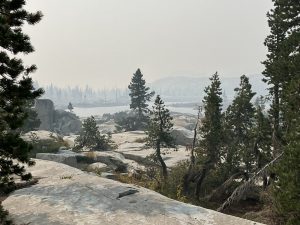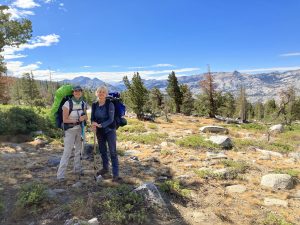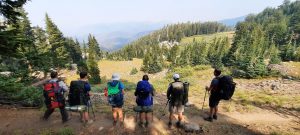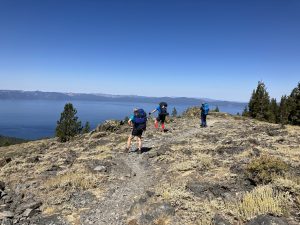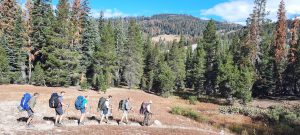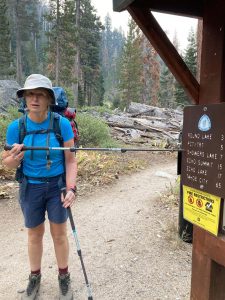Sixteen members from the National Reserve Headquarters Royal Artillery (NRHQ RA) took part in Exercise COCKNEY RATTLESNAKE 22 in September 2022, an overseas adventurous training expedition to the Lake Tahoe region of California and Nevada, USA. The aim was to complete the 172-mile Tahoe Rim Trail (TRT) around the Lake Tahoe basin rim (not shore edge!) in 16 days, wild camping along the route and with planned resupply points. With two available Mountain Leaders from NRHQ RA, the groups had 7 members each and the Support Team of 2.
Personnel were drawn from across the unit and as a national rather than regional Reserve unit, we converged from all corners of the UK and in one instance, from Austria. In many cases this was the first meeting for individuals. Parallel to personal development, leadership and working under pressure, teamwork and cohesion were key objectives in the expedition plan. All this and more were tested to the full immediately prior to our departure. With little more than a month before deployment there was a change of Expedition Lead. Testament to resilience and determination, the new Leader took over the plan and succeeded in gaining all the remaining authorisations, clearances and permits for the expedition to continue.
The Tahoe Rim Trail (TRT) was envisioned by US Forest Service Recreation Officer, Glen Hampton in 1981 and construction of the trail was finished in 2001, predominantly by volunteers. The lake itself sits at 6,231 feet with the highest point of the trail at Relay Peak, cresting at 10,285 feet. Trekkers who complete the circumnavigation of Lake Tahoe ascend and descend close to the equivalent height of Mt Everest from sea level. Everest sits at 29,000 and the total elevation of the TRT is 28,000 feet. Of equal note, the trail shares most of its western edge with the slightly longer (2,650 miles) Pacific Crest Trail (PCT) which runs from Canada to Mexico – maybe one for intrepid Reservists in the future??!
During the transit from Woolwich to Reno, the location for acclimatisation, the Exercise Lead and Mountain Leaders revised the start point for circumnavigation. The original starting point was Tahoe City (a city in name only, no more than a large village) on the west shore of the lake. This was revised to Spooners Summit on the east shore. Several factors played into this decision: Tahoe City was very busy as arrival coincided with Labor Day (a Public Holiday) and the local trail was expected to be busy; the ascent out of Tahoe City was one of the steepest and longest, and water availability (streams for filtration and purification) was unknown. This, along with a local heatwave where temperatures were expected to reach 40 degrees, was the reason to replan the start point to allow for acclimatisation.
Packing light was essential, but where to reduce the weight? Everybody had their own ideas but essential equipment for wild camping included tent, sleeping bag, cooker, food, bear box, spare clothes (optional but it did get cold, 0 degrees overnight some nights), filtration system and water, water, water. Terrain, weather and water availability dictated the volume of water carried and distances for each leg of the trail, as did accessibility for the admin team to rendezvous with the trekkers for food resupply. In some areas along the trail water was abundant in streams and lakes but other stretches had nothing so consequently, we started our first day carrying a minimum of 7 litres each. By necessity, we all carried a bear box to store food and any item with a smell that might attract unwanted attention which included all toiletries, sun creams etc. Shaped like a barrel with a tamper proof lid the boxes occupied a significant proportion of rucksack capacity. It wasn’t all bad, the boxes doubled up as a handy stool to sit on whilst cooking and during the day, food stayed protected in the sturdy canister in the rucksack.
A daily routine was quickly established with early starts, reveille between 0530 and 0600 before first light, so that a large chunk of the trekking could be done before the hottest parts of the day. But as the expedition continued (thankfully!) the temperature dropped and the availability of water increased, reducing the volume and weight carried. On our fourth day we were saddened to hear the news of the passing of The Queen. Surrounded by the serenity of the trail, individually and collectively we took a moment to reflect.
The scenery is without question really beautiful but having completed just over half of our circumnavigation and as we entered Desolation Wildness, we encountered two more significant events. The first, the requirement to extract a member of the trekking party with a medical issue and the second, the downwind smoke hazard from the Mosquito Fire. The extraction while unwelcome for all concerned was executed efficiently and effectively with minimal disruption. The smoke however, had a far more reaching impact. The Mosquito Fire had become California’s largest of the year and while not in danger from the fire, the smoke had started to engulf the western edge of the Tahoe Rim Trail. The US use an Air Quality Index measured out of 500 with 0-50 Good, 51-100 Moderate, 101-150 Unhealthy for sensitive groups, 151-200 Unhealthy, 201-300 Very Unhealthy and 300+ being Hazardous. The air quality had become progressively worse and as both groups reached Tahoe City, after ten days of trekking, the readings breached 200 with a forecast to exceed 350 on the next stage of the trail. Following local medical advice, it was very reluctantly decided to abort the completion of the trail and relocate away from the Mosquito Fire downwind hazard to Samuel P Taylor State Park, north of San Francisco. From there we continued to complete day treks from our now smoke free campsite. While not the culmination of the trekking phase as planned, the last day’s trek seamed fittingly poignant finishing on a beach along the Pacific Ocean and looking out to sea.
Maximising the proximity to San Francisco expedition members, undertook cultural tours of Alcatraz Island and USS Hornet. This was the aircraft carrier that launched the Doolittle raid on Tokyo in WWII before returning to the UK.
Reflections from a trekker on the TRT – on first sight of Lake Tahoe, I thought what could be easier than a stroll around the shoreline. I could not have been more wrong! Setting off in close to 40 degrees heat with what must have been upwards of 25 kg on my back and then some ten days later feeling the day to night temperature change from 22 to 0 degrees and with smoke from a forest fire rolling in, was enough to focus the mind. Did I mention the ascents and descents – a little bit up and a little bit down, I seem to remember was the daily description of the route! All that said, what an experience! The adaptability, resilience and determination of personnel was truly commendable and if I was asked to go back and complete the Tahoe Rim Trail my answer would be no, I want to go back and do the whole thing in one go!
For a National Reserve Unit dispersed across the UK and Europe, Adventurous Training is invaluable for cohesion and bonding. Opportunities are few and far between and it is only with the continued support of the Ulysses Trust that they remain feasible and affordable for Reserve personnel. On behalf of the National Reserve Headquarters Royal Artillery and those members that took part, we wholeheartedly thank the trust for its support in making these activities possible.
By Maj Paul Dean, NRHQ RA
Additional article
Extract from Capt Charlie Calderwood’s personal blog on the trail – hopefully amusing and useful to those looking to purchase a new tent (front or side entry both have pros and cons)
‘Unfortunately, I have developed a bad habit of waking at around 3.30am, getting out of the tent, and trying to tip-toe to the toilet, through broken and brittle branches, leaves and the dust that are a constant here. On returning to my tent, by now with headtorch on, the graceless act of ‘tentry’ begins. Reversing in, the feet must be first past the threshold, being careful not to tread on the pillow, to prevent contamination, but also to prevent rapid deflation! Once a firm grounding beyond the pillow is established the steady shimmy backwards begins and the body disappears smoothly into the tent…except it never actually does, does it? A slip at the foot end causes the bodyweight to collapse down on to a knee, which the brain tries to keep from having a heavy pillow landing, causing a twist and an impromptu press-up style recovery move just outside the tent. The hands, now covered in dirt must be cleaned (still in the press-up position) one at a time, and the rearward slide ungracefully into the tent continues. Due to the headtorch being on, one has now brought every light-loving creature in the vicinity, into the tent, so a stress inducing assassination or evacuation programme must be initiated, followed by the rapid closing of the portal through which one has entered. Here begins the next drama. Those of you who don’t camp may have endured the annoyance of moving a zip 10cm and feeling it jam on the edge of the material surrounding it. A quick tug in the other direction will often release it and ‘hey presto!’ What those of you who don’t camp will not have experienced is trying to resolve this simple issue in the entrance of a tent. Dread consumes the camper, despite knowing it is extremely likely to happen. Lying in the prone position with no sturdy structure on which to lean, and with the zip connected to a thin piece of material that will move in any direction you pull it, the odds are it will not simply release when tugged the other way. Instead, it will remain exactly as it was. To prevent sharing one’s tent with ALL the local wildlife, this issue must be resolved. The challenge is that it requires not one, but two hands, and therefore with the two knees firmly placed a third point of contact must be established. The elbows must now play their part in the name of stability, as the bodyweight is moved carefully out of the tent until both hands reach the zip puller. With the material released the zip can now be easily pulled to, but obviously that would be too easy. It will jam several times more on its way to closed and with each attempt the body weight moves further forward and with the final pull to close the tent there will suddenly be more weight ahead of the elbows than behind, and then begins the descent of the face into the dirty soil and the smelly shoes and anything else you left there last night. You crawl back into your tent with a couple of dozen flying creatures, beaten and dirty, and hope you can sleep. And the alarm sounds, and it’s time to start the day!’

